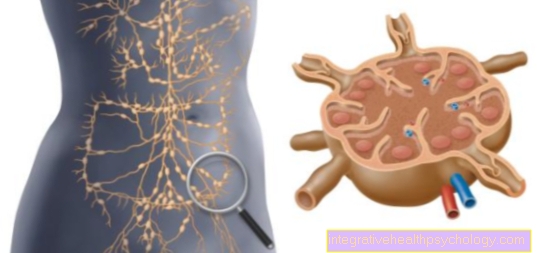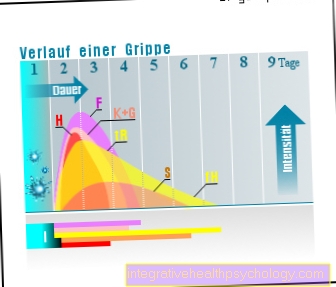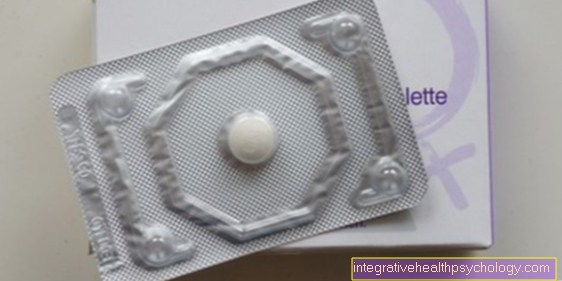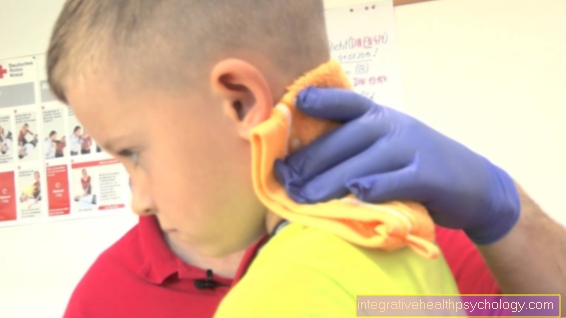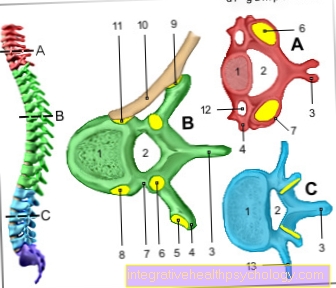Induction of anesthesia
definition
The induction of anesthesia is understood to mean processes that serve to prepare the patient for anesthesia, i.e. an artificially induced state of unconsciousness and painlessness. These preparations are carried out according to a fixed scheme.The induction of anesthesia is followed by continuation of the anesthesia, during which this state of unconsciousness is maintained until the operation is over and the patient can wake up from the anesthesia.
requirements
An important prerequisite for the smooth induction of anesthesia is the consultation with the anesthetist (the Anesthetists), which usually takes place the day before the operation. Here, on the one hand, the patient is informed about the anesthesia itself and about possible side effects of the anesthesia.
On the other hand, the anesthetist receives important information about any previous illnesses of the patient that could play a role in the induction of anesthesia. These include, for example, diseases of the heart and lungs. The question of regular pill intake and the question of allergies (especially drug allergy) are also an important part of the educational discussion.
Usually, blood is also drawn from the patient in order to check various blood values, such as coagulation, before the operation. A physical examination of the patient will also take place. As part of the physical examination, for example, the patient's height, weight, blood pressure and pulse are determined. In addition, the heart and lungs are monitored and the oral cavity is inspected in order to determine potential problems with ventilation in advance.
At the end of the conversation, the anesthetist can prescribe a sleeping pill to ensure the patient a quiet and relaxed night. Sleeping pill can also be given on the morning of the operation to calm the patient down. These sleeping pills are mostly so-called Benzodiazepines. Frequently used representatives of this group are Midazolam and the Lorazepam.
Read more on the topic: Fear of anesthesia / general anesthesia
Procedure for induction of anesthesia
The further course of induction of anesthesia takes place according to a fixed schedule on the day of the operation in a room next to the operating room. First, the function of the equipment that is used to induce anesthesia is checked. This is usually done by a nurse with training in anesthesia.
The nurse then asks for the patient's name and date of birth. This is used to check whether the patient is the correct person and, for example, that files cannot be mixed up. In addition to personal details, the nurse also asks when the patient last ate something.
It is important that the patient is fasted to prevent stomach contents from entering the lungs during induction or surgery. Careful control of the documents and questioning the patient are therefore essential for successful induction of anesthesia.
Observation of the vital signs
Next, a blood pressure cuff is placed on the patient's upper arm, which measures the patient's blood pressure, EKG electrodes are affixed, which represent the patient's heart action, a heart rate monitor is attached to monitor the patient's pulse and a device is used, which measures the oxygen saturation in the blood, clipped onto the finger.
The devices are connected to a monitor. All of these values (blood pressure, heart activity, pulse and oxygen saturation of the blood) are collectively referred to as so-called vital values and can be constantly observed on the monitor during the operation.
Establish access to the venous system
In addition, a vein (usually on the forearm) is punctured in order to establish permanent access to the patient's venous system. Medicines and fluids can be administered to the patient via this access during induction of anesthesia and in the course of the operation.
Depending on the duration of the operation, one or more of these venous accesses are placed. Finally, each patient is given a liquid to drink that neutralizes gastric acid. This is the so-called Tri-Sodium Citrate (TNC).
You might also be interested in this article: Stages of anesthesia
Pre-oxygenation
Now the room is darkened, the doors closed and the actual induction of anesthesia begins. The first step in induction of anesthesia is the so-called preoxygenation. A mask is placed over the nose and mouth of the patient, through which he inhales pure oxygen for a few minutes. This is important because the patient's lungs do not fill with oxygen for a short period of time at the start of anesthesia.
You might also be interested in this topic: Intubation anesthesia
Administration of the pain reliever
Now the patient receives the first medication from the anesthetist through the venous access. This is a strong pain reliever called an opioid. The most commonly used representatives are the fentanyl and the Sufentanilwhich differ only in their onset of action and in their duration of action. The pain reliever can already cause a slight drowsiness or drowsiness. In some cases, the drug also causes an urge to cough.
Administration of the anesthetic
Then the actual anesthetic is injected, which leads to anesthesia, i.e. unconsciousness. Propofol is often used for this. Now the patient is no longer able to breathe independently and breathing is taken over by the anesthetist.
For this purpose, as with pre-oxygenation, a mask is placed over the mouth and nose. This is connected to a pressure bag, through which air is pumped into the lungs.
Administration of muscle relaxants
If there are no problems with this so-called bag-mask ventilation, a third drug is administered, which serves to switch off the muscle function. Medicines that prevent the muscles from contracting during surgery are called muscle relaxants.
Frequently used representatives of this group are called Atacurium and Rocuronium. Similar to painkillers, these two drugs also differ in the onset of action and their duration of action, so you decide which is the more suitable substance depending on the type and duration of the operation.
By preventing muscle tension, muscle relaxants facilitate the intubation that takes place in the next step on the one hand and the operation itself on the other hand. The patient must of course continue to be ventilated during the operation.
There are two main methods available for this, ventilation using a laryngeal mask or ventilation using a tube. The laryngeal mask consists of a plastic tube and an inflatable rubber ring, which is placed around the entrance to the windpipe. The tube is a plastic tube that is inserted into the windpipe. This process is called intubation.
The laryngeal mask is easier to use and also gentler on the pharynx, while the tube, on the other hand, offers more reliable protection against the leakage of stomach contents into the lungs. Which of these two methods is used to ventilate the patient depends, among other things, on the type of operation and the duration of the operation.
Read more on the subject at: Types of anesthesia - which are there?
Continuation of anesthesia
Once the patient has been successfully ventilated using a laryngeal mask or intubation, the induction of anesthesia is complete and anesthesia is continued, in which the unconscious and painless condition (anesthesia) must be maintained during the operation.
In emergency situations, the induction of anesthesia can of course deviate from the above-mentioned scheme, for example, the anesthesiologist can then dispense with the explanation and other drugs are sometimes used to induce anesthesia, namely those with a faster onset of action.
Just as there is the beginning of anesthesia, there is also the end or transition period in which the patient slowly wakes up. This process has its own sequence and is described in detail in our next article: Anesthesia diversion - procedure, duration and risks
What drugs are used?
General anesthesia is made up of three drug groups. The first group are the anesthetics, which are supposed to turn off consciousness. These include, for example Propofol or some gases. The second group are the pain relievers. In most cases, these are narcotic drugs, such as fentanyl.
The last group are the muscle relaxants. These are necessary so that the ventilation does not have to work against the muscles. these are Succinylcholine or Rocuronium. The exact choice of medication is individually tailored to the patient.
In what order are the drugs given?
In most anesthesia inductions, awareness is started first with propofol or anesthetic gas. This means that the person concerned is not aware of the induction of anesthesia as much as possible.
Thereafter, the pain reliever is usually given and then the muscle-relaxing drug. As soon as the muscles relax, ventilation must be started. Particularly anxious patients or children are given soothing medication beforehand on the ward, so that they are hardly aware of the actual initiation.
Special features in the child
"Children are not little adults", one of the most famous phrases in pediatrics. Children are usually given a sedative before they even enter the operating theater to ease their fear. The medication must be adapted very precisely to the child, as the metabolism works differently and children are very light.
Children also need smaller tools for ventilation, which must be in the appropriate and adjacent sizes.
In the rescue service
Anesthesia induction in the rescue service, i.e. in the living room, on the street or at best in the ambulance, is always associated with a significantly increased risk. The patient is completely unknown to the team. Neither the medical history nor allergies can be evaluated.
In addition, the person concerned will usually not be sober, which can significantly endanger the ventilation situation. Emergency anesthesia is only performed when there is no alternative. Strong pain and calming therapy and speedy transport to the nearest clinic are preferred.


